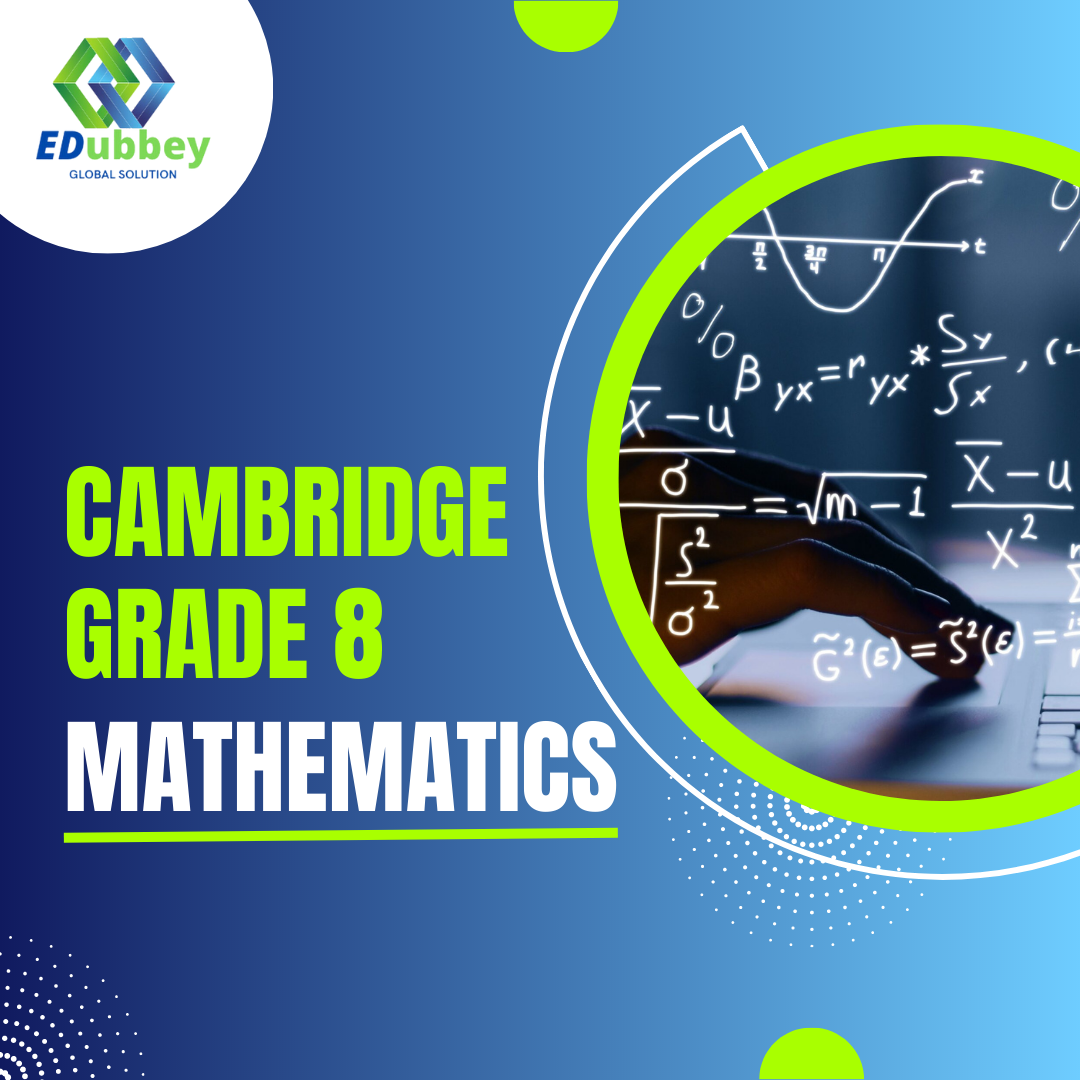- Understand and digest the topics in a easy to remember manner
- Take note of the important information
- Familiar with the Cambridge style of asking questions
- Be able to answer any questions related to each topic
- chapter 1.1: Factors, multiplies and primes.
- Activity 1.1.1
- Activity 1.1.2
- chapter 1.2: Multiplying and dividing integers
- Activity 1.2.1
- Activity 1.2.2
- chapter 1.3: Square roots and cube roots
- Activity 1.3.1
- Activity 1.3.2
- chapter 1.4: Indices
- Activity 1.4.1
- Activity 1.4.2
- chapter 2.1: Constructing expressions
- Activity 2.1.1
- Activity 2.1.2
- chapter 2.2: Using expression and formulae
- Activity 2.2.1
- Activity 2.2.2
- chapter 2.3: Expanding brackets
- Activity 2.3.1
- Activity 2.3.2
- chapter 2.4: Factorisation
- Activity 2.4.1
- Activity 2.4.2
- chapter 2.5: Constructing and solving equations
- Activity 2.5.1
- Activity 2.5.2
- chapter 2.6: Inequality
- Activity 2.6.1
- Activity 2.6.2
- chapter 3.1: Multiplying and dividing 0.1 and 0.01
- Activity 3.1.1
- Activity 3.1.2
- chapter 3.2: Rounding
- Activity 3.2.1
- Activity 3.2.2
- chapter 4.1: Ordering decimals
- Activity 4.1.1
- Activity 4.1.2
- chapter 4.2: Multiplying decimals
- Activity 4.2.1
- Activity 4.2.2
- chapter 4.3: Dividing decimals
- Activity 4.3.1
- Activity 4.3.2
- chapter 4.4: Making decimals calculation easier
- Activity 4.4.1
- Activity 4.4.2
- chapter 5.1 Parallel lines
- Activity 5.1.1
- Activity 5.1.2
- chapter 5.2: The exterior angle of a triangle
- Activity 5.2.1
- Activity 5.2.2
- chapter 5.3: Construction
- Activity 5.3.1
- Activity 5.3.2
- chapter 6.1: Data collection
- Activity 6.1.1
- Activity 6.1.2
- chapter 6.2: Sampling
- Activity 6.2.1
- Activity 6.2.2
- chapter 7.1: Fractions and recurring decimals
- Activity 7.1.1
- Activity 7.1.2
- chapter 7.2: Ordering fractions
- Activity 7.2.1
- Activity 7.2.2
- chapter 7.3: Subtracting mixed number
- Activity 7.3.1
- Activity 7.3.2
- chapter 7.4: Multiplying an integer by a mixed number
- Activity 7.4.1
- Activity 7.4.2
- chapter 7.5: Dividing integers by proper fractions
- Activity 7.5.1
- Activity 7.5.2
- chapter 7.6: Making fraction calculation easier
- Activity 7.6.1
- Activity 7.6.2
- chapter 8.1: Quadrilaterals and polygons
- Activity 8.1.1
- Activity 8.1.2
- chapter 8.2: The circumference of a circle
- Activity 8.2.1
- Activity 8.2.2
- chapter 8.3: Three Dimensional shapes
- Activity 8.3.1
- Activity 8.3.2
- chapter 9.1: Generating sequences
- Activity 9.1.1
- Activity 9.1.2
- chapter 9.2: Find rules for sequences
- Activity 9.2.1
- Activity 9.2.2
- chapter 9.3: using the nth term
- Activity 9.3.1
- Activity 9.3.2
- chapter 9.4: Representing simple function
- Activity 9.4.1
- Activity 9.4.2
- chapter 10.1: Percentage increase and decrease
- Activity 10.1.1
- Activity 10.1.2
- chapter 10.2: Multiplier
- Activity 10.2.1
- Activity 10.2.2
- chapter 11.1: Functions
- Activity 11.1.1
- Activity 11.1.2
- chapter 11.2: Plotting a graphs
- Activity 11.2.1
- Activity 11.2.2
- chapter 11.3: Gradient and intercept
- Activity 11.3.1
- Activity 11.3.2
- chapter 11.4: Interpreting graphs
- Activity 11.4.1
- Activity 11.4.2
- chapter 12.1: Simplifying ratios
- Activity 12.1.1
- Activity 12.1.2
- chapter 12.2: Sharing in a ratio
- Activity 12.2.1
- Activity 12.2.2
- chapter 12.3: Ratio and direct proportion
- Activity 12.3.1
- Activity 12.3.2
- chapter 13.1: Calculating probabilities
- Activity 13.1.1
- Activity 13.1.2
- chapter 13.2: Experimental and theoretical probabilities
- Activity 13.2.1
- Activity 13.2.2
- chapter 14.1: Bearings
- Activity 14.1.1
- Activity 14.1.2
- chapter 14.2: The midpoint of<M
- Activity 14.2.1
- Activity 14.2.2
- chapter 14.3: Translating 2D shapes
- Activity 14.3.1
- Activity 14.3.2
- chapter 14.4: Reflecting shapes
- Activity 14.4.1
- Activity 14.4.2
- chapter 14.5: Rotating shapes
- Activity 14.5.1
- Activity 14.5.2
- chapter 14.6: Enlarging shapes
- Activity 14.6.1
- Activity 14.6.2
- chapter 15.1: Converting between miles and kilometres
- Activity 15.1.1
- Activity 15.1.2
- chapter 15.2: The area of a parallelogram and trapezium
- Activity 15.2.1
- Activity 15.2.2
- chapter 15.3: Calculating the volume of a triangular prisms
- Activity 15.3.1
- Activity 15.3.2
- chapter 15.4: calculating the surface area of triangular prisms and pyramids
- Activity 15.4.1
- Activity 15.4.2
- chapter 16.1: Interpreting and drawing frequency diagram
- Activity 16.1.1
- Activity 16.1.2
- chapter 16.2: Time series graphs
- Activity 16.2.1
- Activity 16.2.2
- chapter 16.3: Stem-and-leaf diagrams
- Activity 16.3.1
- Activity 16.3.2
- chapter 16.4: Pie charts
- Activity 16.4.1
- Activity 16.4.2
- chapter 16.5: Representing data
- Activity 16.5.1
- Activity 16.5.2
- chapter 16.6: Using statistics
- Activity 16.6.1
- Activity 16.6.2
- Computer device
- Internet Connection
This course contains well-explained interactive content for the Cambridge Grade 8 Mathematics Syllabus. In each chapter, a list of related activities is given to strengthen the student's understanding.
The slides present the topics in a concise and easy-to-understand manner. In each topic, a series of activities are treated based on the marking scheme to speed up the student's understanding.
Specific information
Each chapter contains detailed, necessary information on the new curriculum topics (2022–2025). No repetition or boring information is included. Interactive activities are presented along with each topic. This makes it easier for students to familiarize themselves with the answers in every Chapter.
This course is useful for both teachers and students. Teachers don’t need to spend hours creating learning resources for students. The slides are well-explained and coherent.
-
 Tue, 09-May-2023Edubbey Interactive Contents
Tue, 09-May-2023Edubbey Interactive Contents -
 Wed, 10-May-2023Edubbey Interactive Contents
Wed, 10-May-2023Edubbey Interactive Contents -
 Thu, 22-Jun-2023
Thu, 22-Jun-2023 -
 Thu, 22-Jun-2023Edubbey Interactive Contents
Thu, 22-Jun-2023Edubbey Interactive Contents -
 Fri, 23-Jun-2023Edubbey Interactive Contents
Fri, 23-Jun-2023Edubbey Interactive Contents -
 Mon, 03-Jul-2023Edubbey Interactive Contents
Mon, 03-Jul-2023Edubbey Interactive Contents -
 Thu, 13-Jul-2023Edubbey Interactive Contents
Thu, 13-Jul-2023Edubbey Interactive Contents -
 Wed, 20-Sep-2023Edubbey Interactive Contents
Wed, 20-Sep-2023Edubbey Interactive Contents -
 Sat, 24-May-2025muhammad muhammad2Very nice course
Sat, 24-May-2025muhammad muhammad2Very nice course





Write a public review